|
|
JAMES BOND
|
|
|
JAMES BOND
|
|
||||||
|
||||||
|
Part Three: Film Tie-in editions 1962-1974 Beginning with the release of the first James Bond film Dr. No in 1962, PAN Books published a film tie-in edition that boosted sales of the novel and promoted interest in other Ian Fleming titles. In some cases the film tie-in was the only version of that novel then available in paperback. PAN Books sales records indicate that during the release of every film from 1962-1974, sales of that particular title were not surprisingly higher than at any other time. Although the 10 titles released by PAN with a film tie-in cover appeared alongside (and sometimes in place of) other covers in the series, they stand alone as collectible memorabilia from a time when the films for the most part, were actual adaptations of the novel they were cross-promoting. |
||||||
|
||||||
|
||||||
|
||||||
|
To meet the demand generated by the release of the film, the DR. NO film tie-in cover was reprinted eight times from 1962-1964. Originally starting out as X335 (which turned out to be a printing error, as the correct PAN number should have been G335), DR. NO was renumbered as X237 in 1963 when the Raymond Hawkey series was first published, and then later issued with a new Hawkey designed cover in May 1964. |
||||||
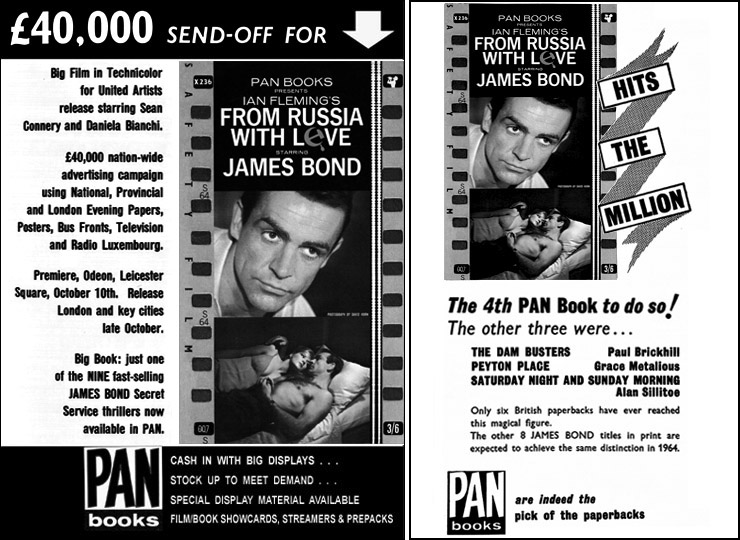 |
||||||
|
FROM RUSSIA, WITH LOVE was still in circulation featuring two different painted covers by Sam Peffer in 1959, and Pat Owen from 1961, and was re-issued from the 12th printing in 1963 with a film tie-in cover. The FROM RUSSIA, WITH LOVE film tie-in edition also featured a die-cut front cover with holes punched out to represent the sprockets of 35mm film stock. The laminated glossy colour wrap-around cover featured four publicity photos by David Hurn, and was superseded by the Raymond Hawkey designed cover in July 1964, which appeared from the 17th - 21st editions. In January 1964 FROM RUSSIA, WITH LOVE became the fourth PAN Book to sell over a million copies in Great Britain - the first James Bond novel to reach the magical figure. Five more titles achieved this distinction within days of each other in May 1964. 183,300 copies of FROM RUSSIA, WITH LOVE were sold in October 1963 alone as the second James Bond film was on general release in the UK. |
||||||
|
||||||
|
Once again PAN Books, in conjunction with EON Productions, ran a competition for booksellers promoting the release of From Russia With Love in October 1963. The Exhibitors’ Campaign Book detailed the terms and conditions similar to the Dr. No competition which ran in the previous year. First prize this time was £50 plus a trip to Pinewood Studios, with return rail travel and one-night in a London hotel for two people. The cross-promotion of the film and PAN paperback resulted in huge sales in 1963/64 with around one-and-a-half million copies sold in the UK alone. Boots of Western Road, Brighton [pictured below left] were winners of the first prize of £50. |
||||||
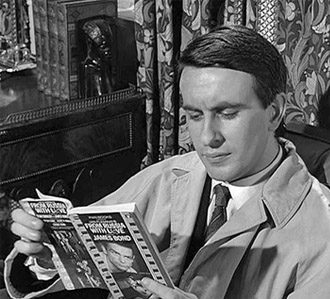 |
||||||
|
The PAN paperback tie-in of FROM RUSSIA, WITH LOVE was also seen in an episode of the second series of Danger Man which starred Patrick McGoohan as John Drake. The lead actor had turned down the role of James Bond in 1962 on moral grounds, and would later decline the role of Simon Templar in The Saint. Peter Gill as Fletcher [pictured above right] is seen reading the paperback in the episode entitled The Ubiquitous Mr. Lovegrove from February 1965, which also featured Desmond Llewellyn who had made his debut as Q in From Russia With Love in 1963. |
||||||
|
||||||
|
In April 1964 PAN Books published the third film tie-in ahead of the premiere of Goldfinger on 17th September at London's ODEON Leicester Square. The wrap-around cover featured Robert Brownjohn's alternate golden girl image [model and actress Margaret Nolan] with a section torn-out on the rear revealing the From Russia With Love poster underneath. This design had initially appeared on EON Productions press releases in early 1964, so was not initiated or designed by PAN Books. |
||||||
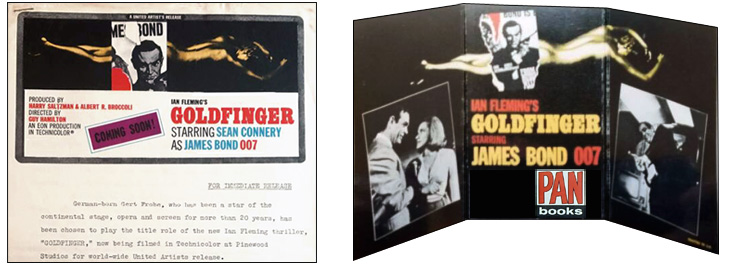 |
||||||
|
||||||
|
||||||
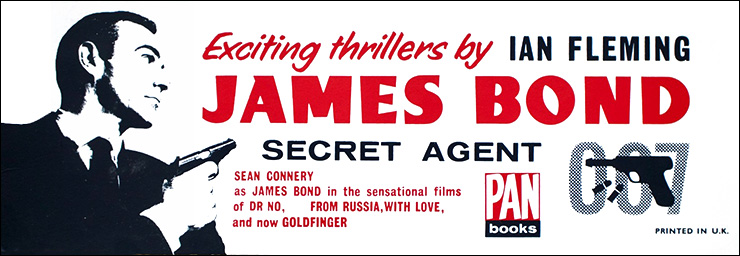 |
||||||
|
Sales of the James Bond novels in paperback had reached record levels by the end of 1964, and were significantly boosted with the release of Goldfinger. Total sales of over ten-million copies of Ian Fleming's novels had been sold in the UK; with almost one-million being for GOLDFINGER alone. The PAN film tie-in of GOLDFINGER was reprinted a further eight times, with the last printing of this edition in 1965. The Raymond Hawkey cover was also still in circulation although the PAN advert in the Goldfinger premiere brochure [pictured below left] omits this version from the eight titles then available. Also published in paperback by PAN Books on October 2, 1964, was Ian Fleming's Thrilling Cities Part 1 and trade advertisements [pictured below right] cross-promoted both titles. Thrilling Cities was a two-part anthology travel articles written by Ian Fleming for The Sunday Times, and originally published in weekly instalments in the newspaper in 1957 and 1960. |
||||||
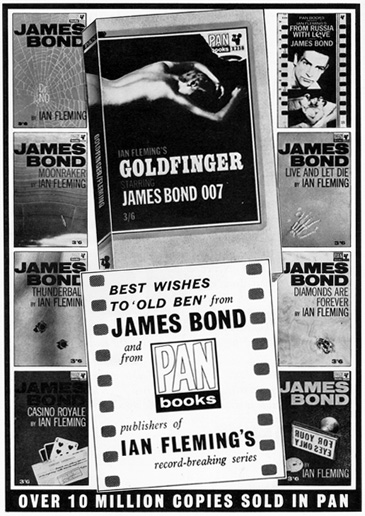 |
||||||
|
Although re-issued in 1969 as part of the ‘white-model’ series, GOLDFINGER went out-of-print in paperback in 1971, and was one of the four titles in the first wave of ‘still-life’ covers in 1972. GOLDFINGER was the second-highest selling title of all the PAN James Bond paperbacks, with a staggering two-and-a-half million copies sold by the end of 1977 when PAN relinquished the paperback publishing rights. |
||||||
|
‘Bondmania’ reached its zenith at the end of 1965 with the release of Thunderball, the fourth film starring Sean Connery as 007. At this time sales of the PAN James Bond paperbacks had reached 20-million in the UK, with nearly seven-million copies sold in 1965 alone. As part of his settlement following the lawsuit he brought against Ian Fleming for plagiarism and false attribution of authorship, Kevin McClory was awarded the screen rights to THUNDERBALL, and publishers were to add the line “This story is based on a Screen Treatment by Kevin McClory, Jack Whittingham, and the author” to all subsequent editions of the novel. The PAN paperback of THUNDERBALL was first published in May 1963 (with Raymond Hawkey's ground-breaking cover design), six-months before the trial eventually reached the high court, and therefore the first twelve printings do not feature the added text. PAN Books added the acknowledgement starting with the 13th printing of the paperback which was issued with the glossy wrap-around film tie-in cover. |
||||||
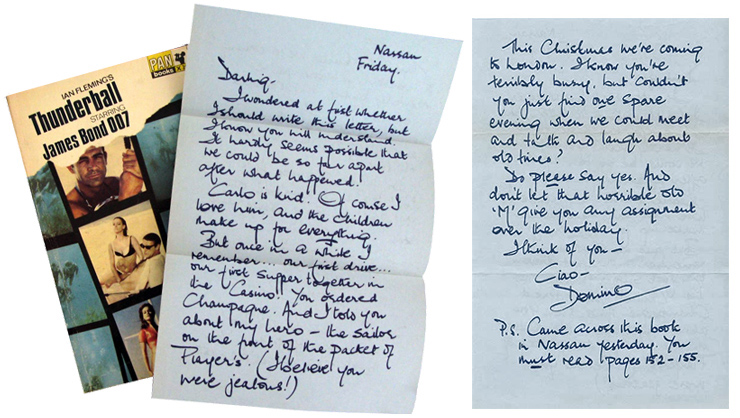 |
||||||
|
||||||
|
The souvenir brochures printed for the London and regional premieres of Thunderball also contained a full-page Player's advertisement showing the third page of another letter from Domino which specifically has reference to the film, and ties the whole cross-promotion together. Very few people would have seen the advertisement, which sheds a little more light on the mystery letter tucked into the paperback, and explains its purpose in the rather politically incorrect 1960s, when cigarette advertising was far more overt than it is today. Although 250,000 copies of the 14th printing of the THUNDERBALL paperback were issued, there is no record of how many Domino letters were inserted. Copies with a genuine original letter are therefore now very hard to find. |
||||||
|
||||||
|
The Thunderball premiere was originally scheduled for October 21, 1965, and the tie-in paperback was to be issued with a first run of 500,000 copies. However, post production delays led to EON Productions delaying the release until December so PAN withheld the paperback until November 5, 1965. PAN Books, EON Productions and United Artists once again ran two competitions to tie-in with the release of Thunderball; the first took place from 1 January - 28 February 1966, and the second from 1 March to 31 May. The competition this time had over £500 worth of prizes in the form of eight gold sovereigns or a ‘James Bond hamper’ worth £31 for the best non-professionally dressed window, and another for the window dressed by full-time display staff. Cinema managers who co-operated with the winning stores received a ‘THUNDERBALL hamper’ worth £15, or four gold sovereigns. In the second part of the competition the prize for best window dressed by full-time display staff was won by Boots, Royal Exchange, Manchester; and that for the best non-professionally dressed window by W. H. Smith, The Broadway, Bradford. Following its December 1965 release, Thunderball then played continuously in London for six months and a double-bill of Dr. No/From Russia With Love was also showing across the country in early 1966. Goldfinger had also been re-released exclusively at the ODEON Haymarket in London, and interest in everything James Bond reached its high-point. Although sales of PAN James Bond paperbacks began to decline, 2.5-million copies were sold in 1966, and by the end of the year overall sales had reached 23-million! |
||||||
|
||||||